Establishment of a Sustainability Assessment System for Bridges
Abstract
:1. Introduction
- Maintain safety management, risk mitigation, and reliability during the life cycle.
- Minimize the CO2 emission during the life cycle and harmful impacts on the environment and ecology.
- Optimize the landscape for the project developed zone.
- Maximize the benefit/function of project development.
- Reduce the waste production and try to possibly recycle the wastes during the life cycle.
- Save energy during the life cycle.
- Extend the durability of the project.
- Preserve the local culture and maintain the social conscience.
- Encourage creativity.
- Keep a reasonable cost during the life cycle.
2. Methodology
2.1. Questionnaire-Based Expert Interview
2.2. Analysis of Questionnaire Data
2.2.1. Top Two Boxes Theory (TTBT)
2.2.2. Multiple Attribute Value Theory (MAVT)
2.2.3. Definition of Each Level’s Weight
3. Development of Assessment System for Green Civil Infrastructure Projects
3.1. Development of Key Indicators for Bridges
- Risk mitigation and reliability
- Ecology
- Environmental protection and carbon emissions reduction (ER and CER)
- Energy saving
- Waste reduction
- Durability
- Benefit and function
- Landscape
- Humanities and culture preservation (H&C)
- Creativity
- Weight determination for each key indicator.
- Project evaluation for sustainability achievement.
3.2. Questionnaire Results Analysis
3.2.1. Expertise and Education of the Experts
3.2.2. Weights for Level 3: Stages of Project Life Cycle
- “j” varies from 4 to 9, depending on the number of evaluation items in each key indicator;
- “i” ranges from 1 to 10, indicating the ten key indicators;
- “nx” (x = 4 and 3) shows the number of experts who give x points (x = 4 and 0) of the importance rate of level 3;
- “n” indicates the total number of experts who participated.
3.2.3. Weight for Level 2: Evaluation Items
3.2.4. Weight for Level 1: Key Indicators
3.3. Calculation for Weights of Sustainability Key Indicators for Bridges
3.3.1. Relative Weight of the Four Stages
3.3.2. The Detailed Calculation Steps for the Weight of Level 3—Four Stages: Wijk
- Mean = (28 × 4 + 13 × 3 + 4 × 2 + 2 × 1 + 0 + 0)/47 = 3.4
- T211 = (28 + 13)/47 = 87.23%
- W211 = 3.4 × 38.68% × 87.23% = 1.16 (W211 denotes second the key indicator, first evaluation item, and first stage)
- Mean = 2.8, T212 = 63.83%, W212 = 0.55
- Mean = 3.0, T221 = 76.60%, W222 = 0.89
- Mean = 2.7, T222 = 63.83%, W222 = 0.53
- Mean = 2.1, T223 = 38.30%, W223 = 0.16
3.3.3. The Detailed Calculation Steps for the Weights of Level 2—Evaluation Items: Wij
- W21 = (1.16 + 0.55)/2 = 0.85
- W22 = (0.89 + 0.53 + 0.16)/3 = 0.52
- W23 = (0.72 + 0.75 + 0.32)/3 = 0.59
- W24 = (1.04 + 0.94 + 0.26)/3 = 0.75
- S2 = (0.85 + 0.52 + 0.59 + 0.75)/4 = 0.679
3.3.4. The Detailed Calculation Steps for the Weights of Level 1—Key Indicators: Wi
- Stotal = S1 + S2 + ………… + S10 = 0.985 + 0.679 + 0.608 + 0.458 + 0.546 + 0.968 + 0.623 + 0.740 + 0.358 + 0.452 = 6.418
- Wi = Si/Stotal
4. Sustainability Evaluation for Bridges Using the SASGCI
4.1. Calculation for the Evaluation
- Very good: 2 points.
- Good: 1 point.
- Not applicable (or average): 0 points.
- Bad: minus 1 point.
- Very bad: minus 2 points.
4.2. Evaluation Results
- Certified grade: the final score must be higher than 50 points.
- Bronze grade: the final score must be higher than 60 points.
- Silver grade: the final score must be higher than 70 points.
- Gold grade: the final score must be higher than 80 points.
- Diamond grade: the final score must be higher than 90 points.
5. Case Study for Bridge Evaluation Using the SASGCI
5.1. Baimi Scenic Bridge (BSB) of Suhua Highway
- Carbon footprint inventory [33,34]: A carbon footprint study indicates that improvements in material manufacturing processes and machinery operation can reduce carbon emission effectively during construction. In the BSB project, engineers focused on two portions: modifying the concrete mixture and improving the operation efficiency of equipment and machines.
- Concrete mixture for carbon reduction [35]: During the construction of BSB, the average carbon emission during cement production is 0.58 kgCO2 e/kg. The concrete mixture was modified by substituting cement with recyclable materials such as coal fly ash (CFA) and ground-granulated blast-furnace slag (GGBFS), which was estimated in the design stage to reduce carbon emissions by 13–18% compared with the average value. In the completion of BSB, the carbon emission was found to be reduced by up to 34–43% from the original estimate.
- Research on specified species [36]: Construction activities can severely impact the habitats of local animal species. In the BSB construction, the biologists developed a research program to monitor changes in species’ population and health during the construction process. A severe variety of the quantity of the local species has caused the suspension of construction work to seek the reasons and resolve the ecology impact.
- Ecological conservation: The highway alignment was adjusted to avoid cutting or removing trees. The electrical control room for the tunnel was built underground to minimize any impact on the aboveground environment. Furthermore, efforts in design have been made to prevent animals from roadkill. Unique shading boards and light-cutting devices have been installed along the road edges to protect insects and other small flying species in the evening.
- Landscape: The highway passes by Baimimal Community, a village located between Suao and the Dongao tunnel. In Chinese, “Baimi” is the pronunciation of “rice”. The structure of Baimi Scenic Bridge is an extradosed bridge with a total length of 340 M. The engineers designed the pylon of the bridge to have a shape like a rice grain. This design incorporates local characteristics into the bridge architecture, making it a pleasant addition to the landscape. Figure 14 show on-site pictures of the BSB [19].
- Cultural preservation: During the excavation of the bridge foundation located near Hanbern, the engineers discovered ancient human ruins, including old tools and goods. This “Hanbern Historic Remains” is the relics of a Neolithic culture that was prevalent in this area 1100–1800 years ago. Because of the archeological significance, the owner asked the bridge construction to stop for several years, until the archaeologist finished their on-site study.
5.2. The Detailed Calculation Steps for Evaluation of BSB of Suhua Highway
- P21 = 2.0 × 1.16 + 2.0 × 0.55 = 3.40
- P22 = 2.0 × 0.89 + 2.0 × 0.53 + 0.0 × 0.16 = 2.83
- P23 = 2.0 × 0.72 + 2.0 × 0.75 + 0.0 × 0.32 = 2.93
- P24 = 2.0 × 1.04 + 2.0 × 0.94 + 2.0 × 0.26 = 4.49
- P2j = 3.07 + 2.84 + 3.22 + 4.03 = 13.65
- P2 = 13.65 × 10.6% = 1.44
- P1 = 3.12, P2 = 1.44, P3 = 1.43, P4 = 0.64, P5 = 1.15, P6 = 2.76, P7 = 1.40, P8 = 1.02, P9 = 0.24, P10 = 0.43
6. Conclusions
Author Contributions
Funding
Institutional Review Board Statement
Informed Consent Statement
Data Availability Statement
Acknowledgments
Conflicts of Interest
References
- World Bank. World Development Report 1994: Infrastructure for Development; Oxford University Press: Oxford, UK, 1994; pp. 1–12. [Google Scholar]
- World Bank. Infrastructure at the Crossroads: Lessons from 20 Years of World Bank Experience; The World Bank: Washington, DC, USA, 2006. [Google Scholar]
- Shen, L.; Wu, Y.; Zhang, X. Key Assessment Indicators for the Sustainability of Infrastructure Projects. J. Constr. Eng. Manag. 2011, 137, 441–451. [Google Scholar] [CrossRef] [Green Version]
- Lopez, F.R.; Sanchez, G.F. Challenges for Sustainability Assessment by Indicators. Leadersh. Manag. Eng. 2011, 11, 321–325. [Google Scholar] [CrossRef]
- Amano, K.; Ebihara, M. Eco-intensity analysis as sustainability indicators related to energy and material flow. Manag. Environ. Qual. 2005, 16, 160–166. [Google Scholar] [CrossRef] [Green Version]
- Huang, R.Y.; Lin, W.H.; Chou, N.N.S.; Liaw, T.T.; Tsai, H.N. Research on Establishment of Sustainability Key Indicator System for Public Infrastructure Projects; Public Construction Committee (PCC) of Executive Yuan, R.O.C.: Taipei, Taiwan, 2008; p. 0970300. (In Chinese) [Google Scholar]
- World Commission on Environment and Development (WCED). Brundtland Report: Our Common Future; Brundtland Commission: Rio de Janeiro, Brazil, 1987. [Google Scholar]
- Liu, T.Y.; Chen, P.H.; Chou, N.N.S. Comparison of Assessment Systems for Green Building and Green Civil Infrastructure. Sustainability 2019, 11, 2117. [Google Scholar] [CrossRef] [Green Version]
- Shau, H.J.; Liu, T.Y.; Chen, P.H.; Chou, N.N.S. Sustainability Practices for the Suhua Highway Improvement Project in Taiwan. Int. J. Civ. Eng. 2019, 17, 1631–1641. [Google Scholar] [CrossRef]
- Liu, T.Y.; Chen, P.H.; Chou, N.S. Sustainability-based Construction of the restoration projects for the Guguan hydropower station. In Proceedings of the 5th International Conference on Environmental Science and Civil Engineering (ESCE2019), Nanchang, China, 13–14 April 2019. [Google Scholar]
- Liu, T.Y.; Chen, P.H.; Chou, N.N.; Chou, M.Y.; Lin, J.J.; Lo, H.T. Environmental Sustainability Approaches Adopted for Construction of Anhsin Bridge of Ankeng Metro System in New Taipei City. E3s Web Conf. 2019, 117, 00013. [Google Scholar] [CrossRef]
- Yates, J.K. Design and Construction for Sustainable Industrial Construction. J. Constr. Eng. Manag. 2014, 140, B4014005. [Google Scholar] [CrossRef]
- Chisholm, D.; Reddy, K.; Beiler, M.R.O. Sustainable Project Rating Systems, Including Envision. In Engineering for Sustainable Communities: Principles and Practices; ASCE: Reston, VA, USA, 2017; Chapter 20. [Google Scholar]
- Chou, N.N.S. The Achievements of Mechanically Stabilized Earth (MSE) Walls on Green/Sustainable Features and Benefits—Safety, Economy, Ecology, and Carbon Emission Reduction. J. Prof. Eng. 2019, 86, 20–26. (In Chinese) [Google Scholar]
- Chou, N.N.S.; Liu, T.Y.; Chen, Y.S.; Cheng, H.C. Comparison of Various Types of MSE Wall Facings. In Proceedings of the 11th International Geosynthetics Conference, Seoul, Korea, 16–21 September 2018. [Google Scholar]
- Huang, R.Y.; Yeh, C.H.; Hsu, W.T. Development of an Appraisal System for Green Highway Construction. J. Technol. 2006, 21, 19–30. (In Chinese) [Google Scholar]
- Greenroads Foundation. Greenroads Rating System Version 2; Greenroads Foundation: Bellingham, WA, USA, 2018. [Google Scholar]
- Ghali, A.; Gayed, R.B.; Kroman, J. Sustainability of Concrete Infrastructures. J. Bridge Eng. 2016, 21, 04016033. [Google Scholar] [CrossRef]
- Liu, T.Y. Establishment of Sustainability Key Indicators for Civil Engineering and Their Applications in Green Infrastructure Projects. Ph.D. Thesis, Department of Civil Engineering, College of Engineering, National Taiwan University, Taipei, Taiwan, 2020. [Google Scholar] [CrossRef]
- Zhong, Y.; Ling, F.Y.Y.; Wu, P. Using Multiple Attribute Value Theory for the Selection of Structural Frame Material to Achieve Sustainability and Constructability. J. Constr. Eng. Manag. 2016, 143, 04016098. [Google Scholar] [CrossRef]
- Patel, R.; Raval, G.; Valiveti, S. Analysis of Energy Consumption in SET TOP BOX: A survey and Opportunities for Energy Saving. Int. J. Comput. Sci. Commun. 2016, 7, 228–235. [Google Scholar]
- Ali, T. What is a Top 2 Box Score? DISPLAYR Blog 2018. Available online: https://www.displayr.com/what-is-a-top-2-box-score/ (accessed on 26 March 2021).
- Xia, B.; Chan, A.P.C. Measuring complexity for building projects: A Delphi study. In Engineering, Construction and Architectural Management; Emerald Group Publishing: Bingley, UK, 2012; Volume 19, pp. 7–24. [Google Scholar]
- Survey-Monkey, “Top Two Boxes Scores”. Survey-Monkey Official Website. 2020. Available online: https://www.surveymonkey.com/mp/top-2-box-scores/ (accessed on 1 July 2020).
- Sambandam, R.; Hausser, G. An Alternative Method of Reporting Customer Satisfaction Scores. Quirk’s Marketing Research Review. October 1998. Available online: https://www.trchome.com/docs/2-alternative-method-of-reporting-scores/file (accessed on 1 July 2020).
- Buede, D.M.; Maxwell, D.T. Rank disagreement: A comparison of multi-criteria methodologies. J. Multi Criteria Decis. Anal. 1995, 4, 1–21. [Google Scholar] [CrossRef]
- Chankong, V.; Haimes, Y.Y. Multi-Objective Decision Making—Theory and Methodology; Dover Publications, Inc.: Mineola, NY, USA, 1983. [Google Scholar]
- Belton, V.; Stewart, T. Multiple Criteria Decision Analysis: An Integrated Approach; Kluwer Academic Publishers: Dordrecht, Germany, 2002. [Google Scholar]
- Leahy, J. Using Excel for Analyzing Survey Questionnaires; University of Wisconsin-Extension: Madison, WI, USA, 2004; G3658-14. [Google Scholar]
- Paul, C. Accessing and Analyzing Data with Microsoft® Excel; Microsoft Press: Redmond, WA, USA, 2003. [Google Scholar]
- Nagel, S.S. Evaluation Analysis with Microcomputers. Public Product. Rev. 1987, 10, 67–80. [Google Scholar] [CrossRef]
- Shau, H.J. Suhua Highway Improvement Project Official Website. 2018. Available online: https://Suhua.thb.gov.tw/ (accessed on 1 July 2020).
- Chou, S.L. Research Report of Carbon Footprint Inventory for Suhua Highway Improvement Project; Suhua Highway Improvement Project Seminar Report; Suhua Highway Improvement Project Office: Taiwan, China, 2014. (In Chinese) [Google Scholar]
- Hsu, P.J. 2013 Annual Progress Report of Carbon Footprint Inventory for Suhua Highway Improvement Project; Suhua Highway Improvement Project Seminar Report; Suhua Highway Improvement Project Office: Taiwan, China, 2013. (In Chinese) [Google Scholar]
- Sinotech Engineering Consultants, Ltd. 2013 Annual Report for Suhua Highway Improvement Project; Suhua Highway Improvement Project, Carbon Footprint Inventory Report; Sinotech Engineering Consultants, Ltd.: Taipei, Taiwan, 2013. (In Chinese) [Google Scholar]
- Shau, H.J. 2012–2016 Annual Research Report on Indicative Species for Suhua Highway Improvement Project; Suhua Highway Improvement Project Annual Report; Suhua Highway Improvement Annual Project: Taiwan, China, 2012–2016. (In Chinese) [Google Scholar]
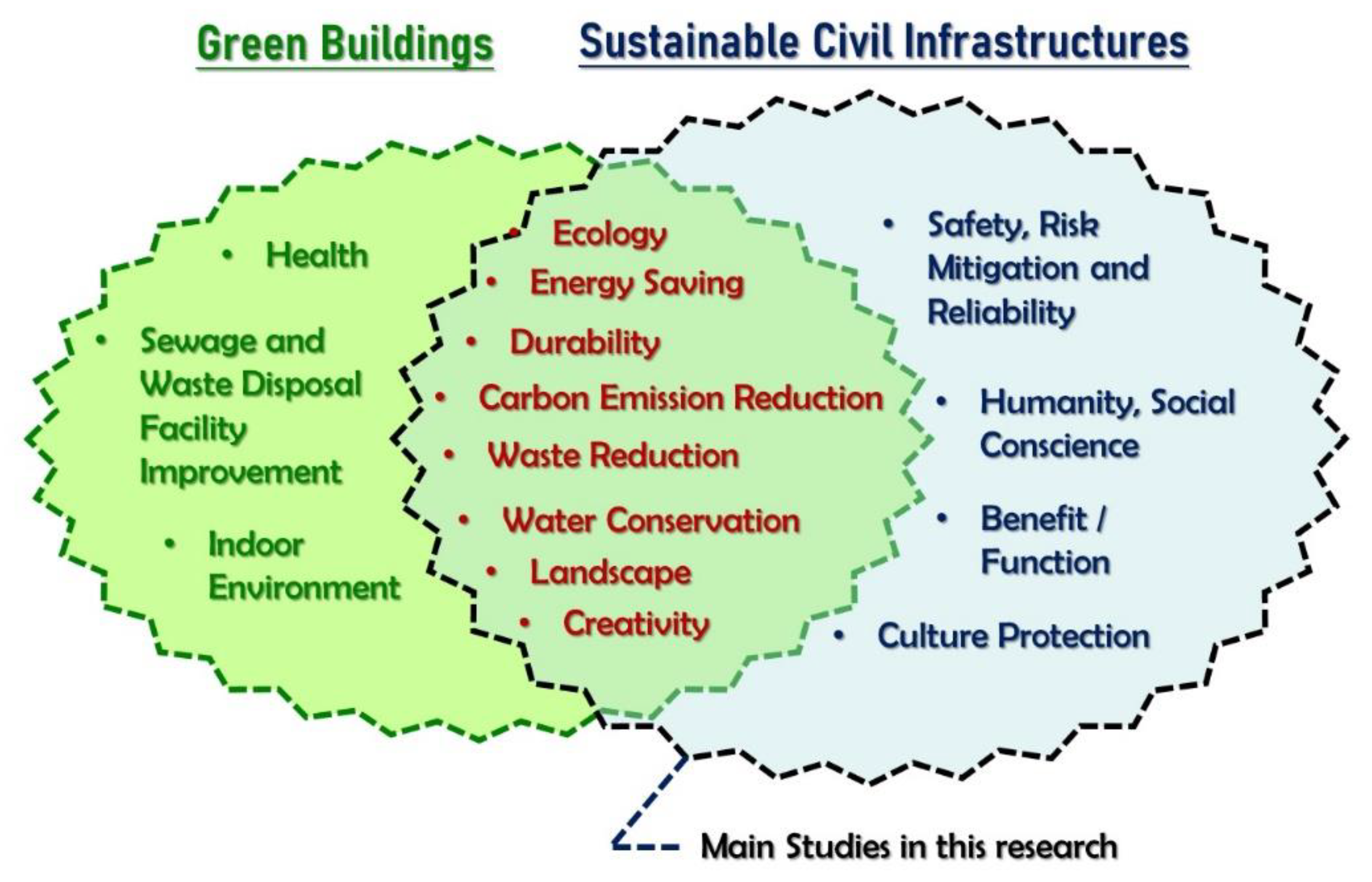
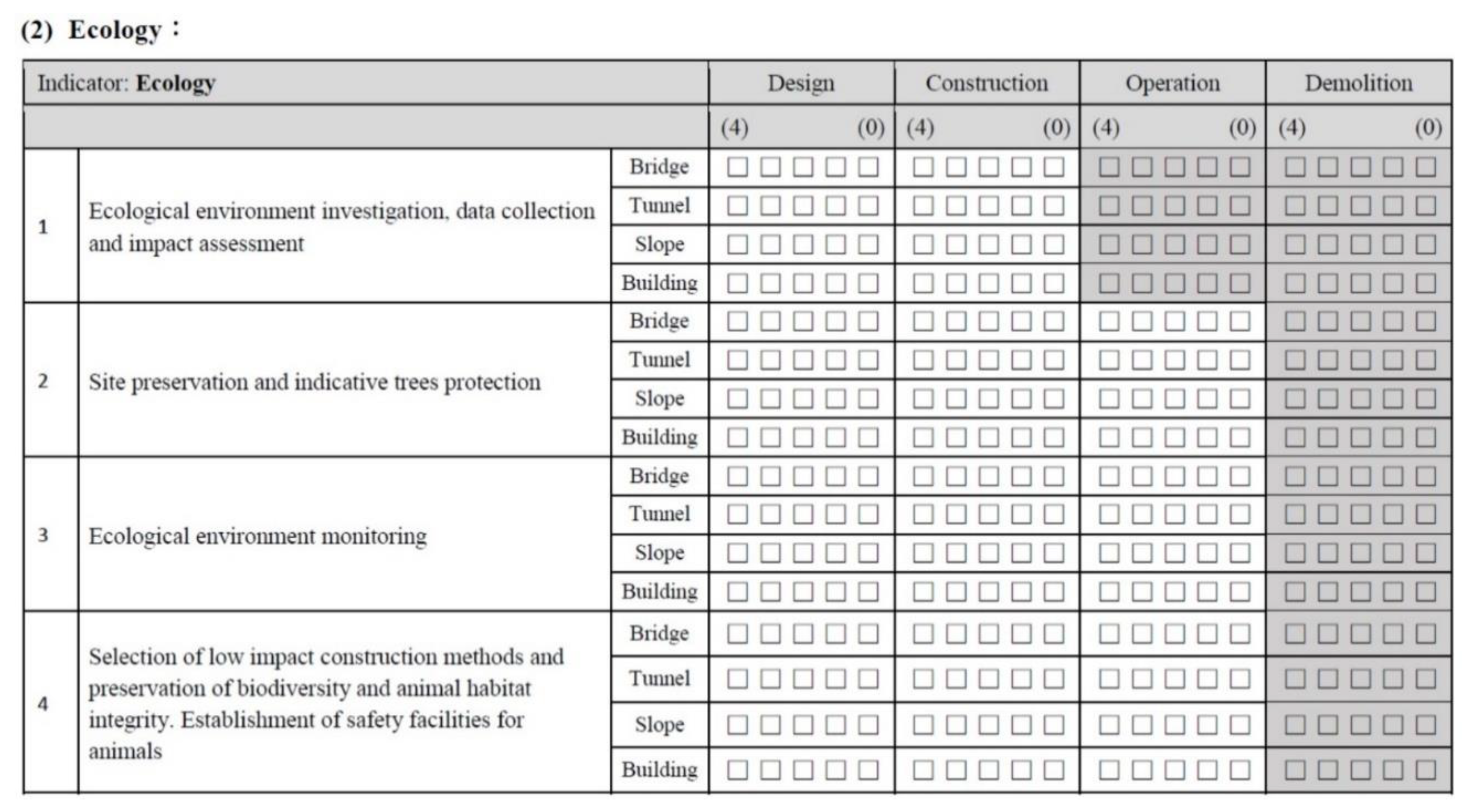




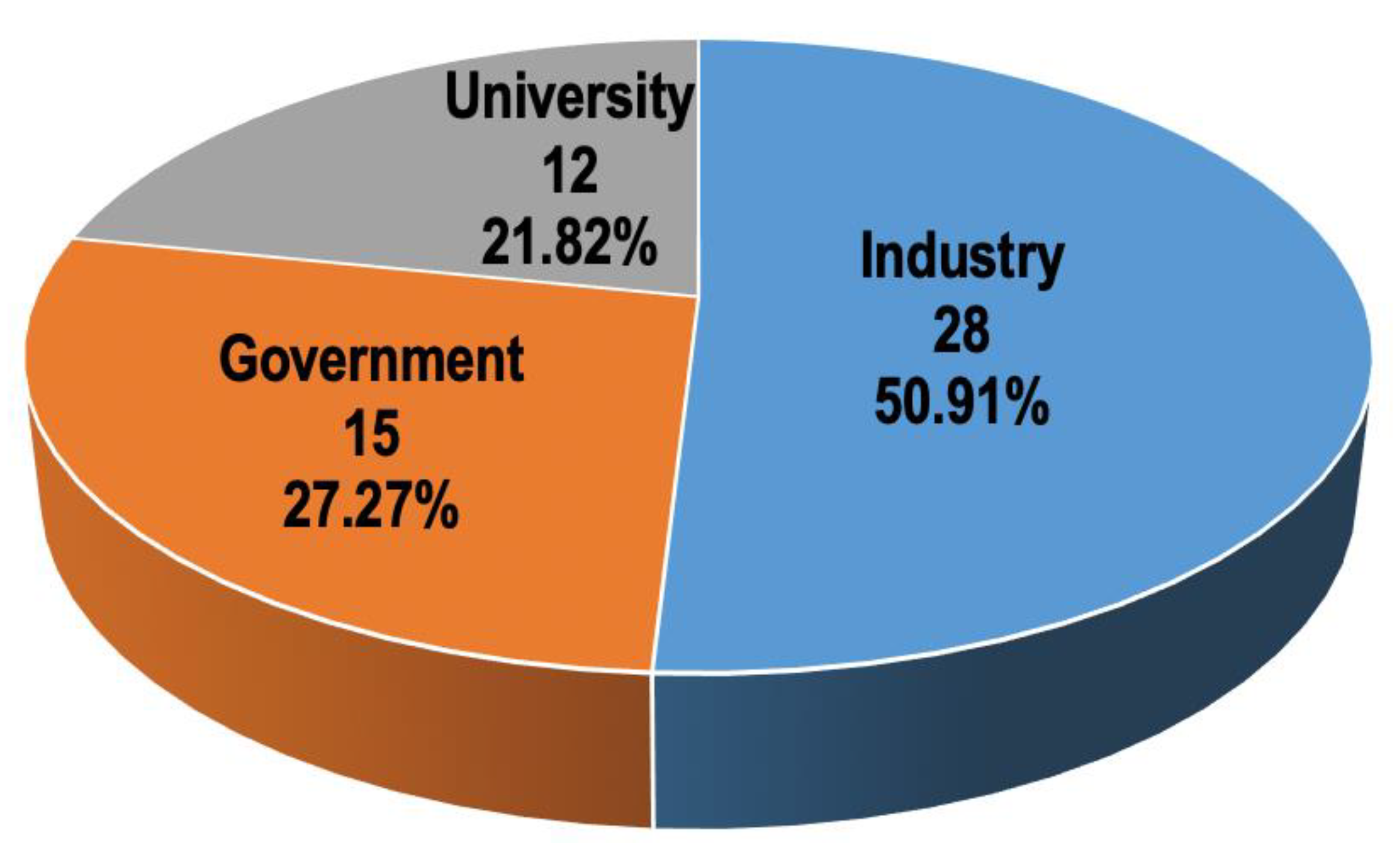

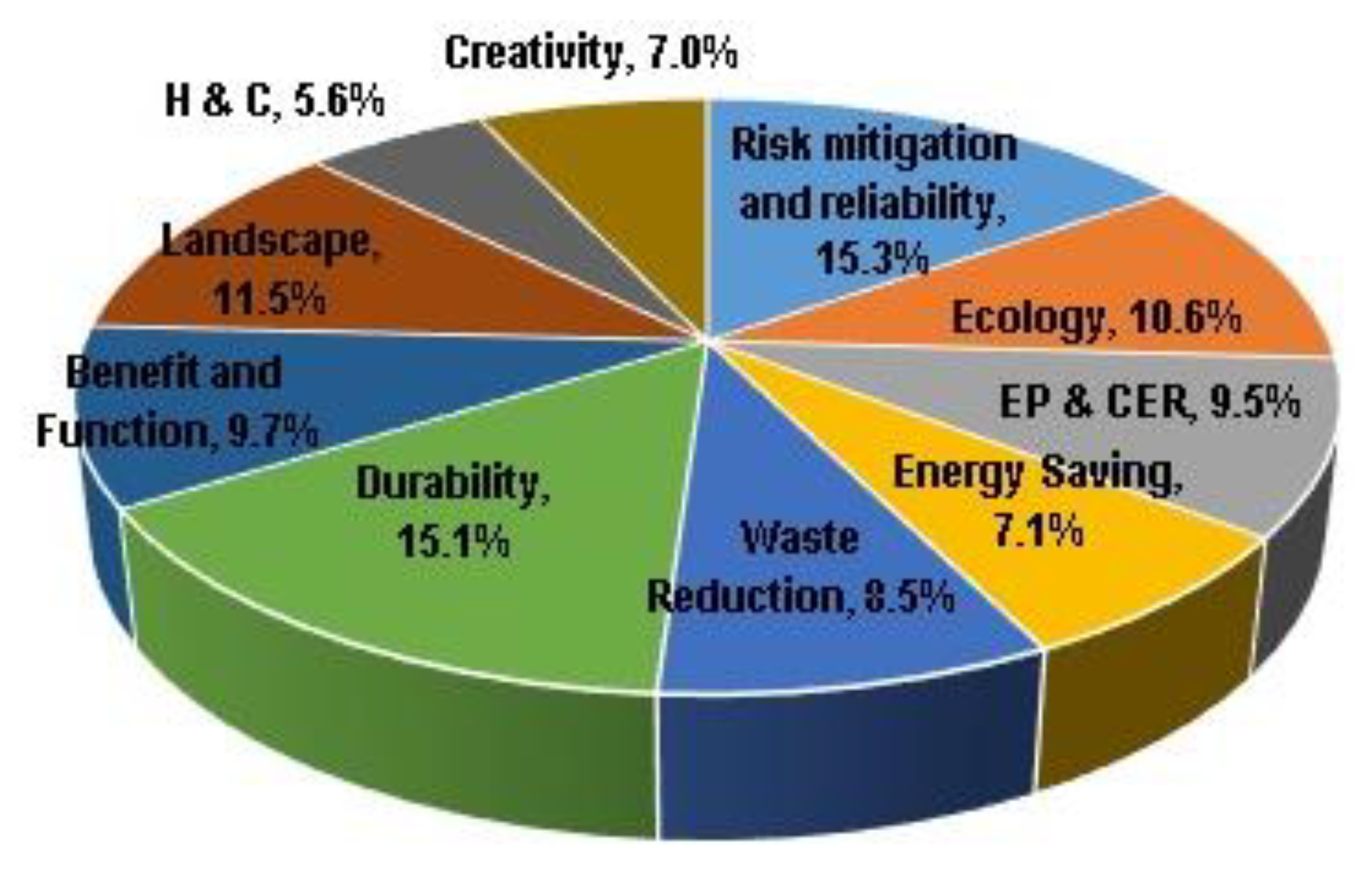
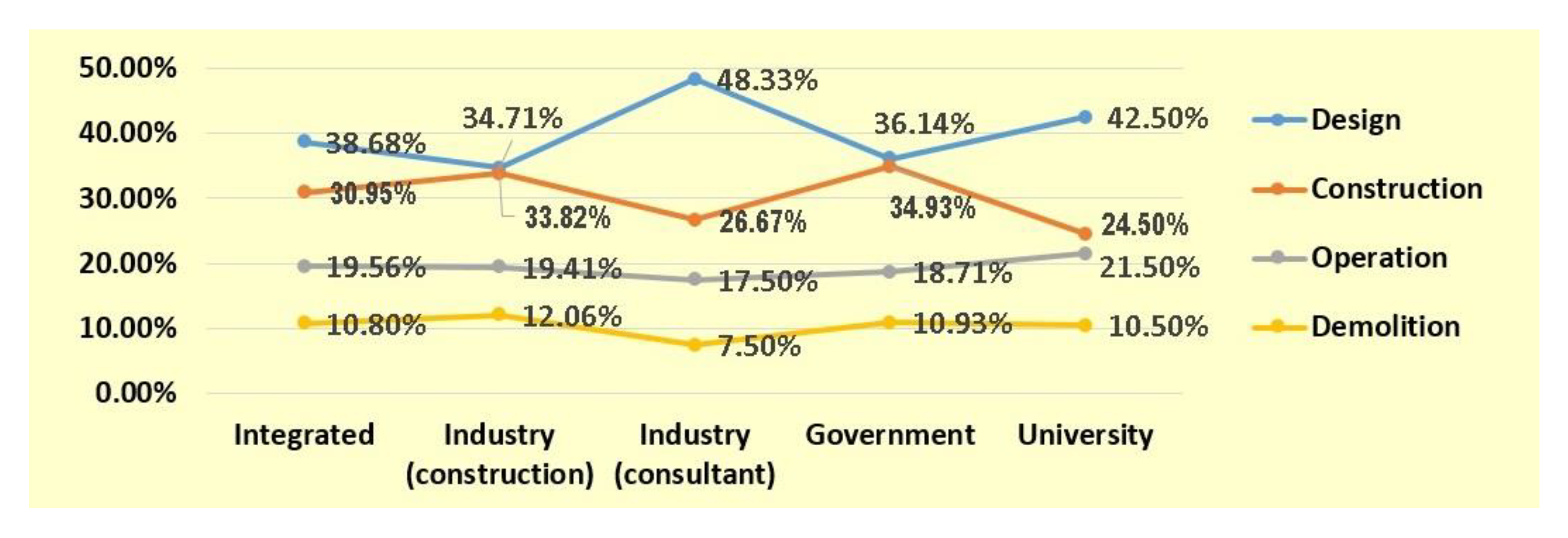
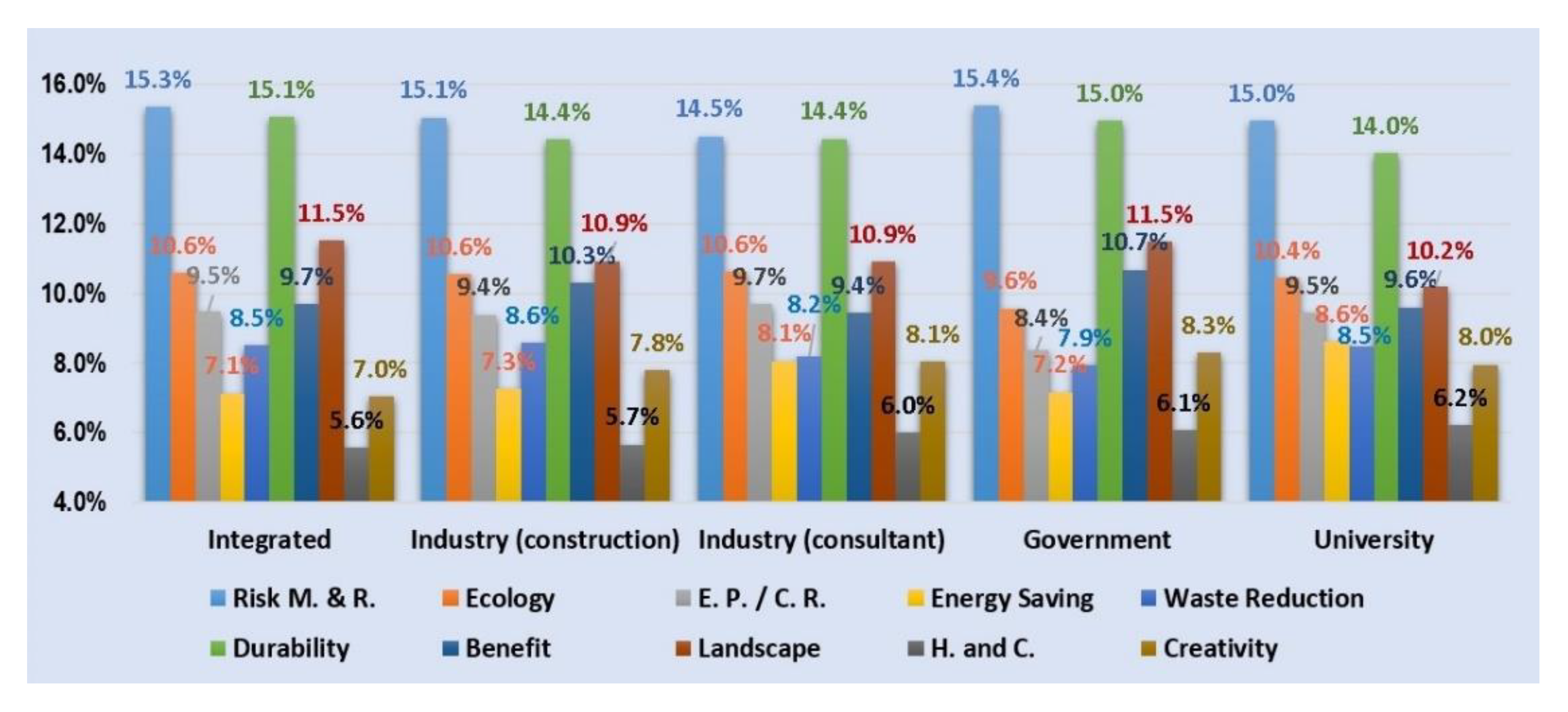
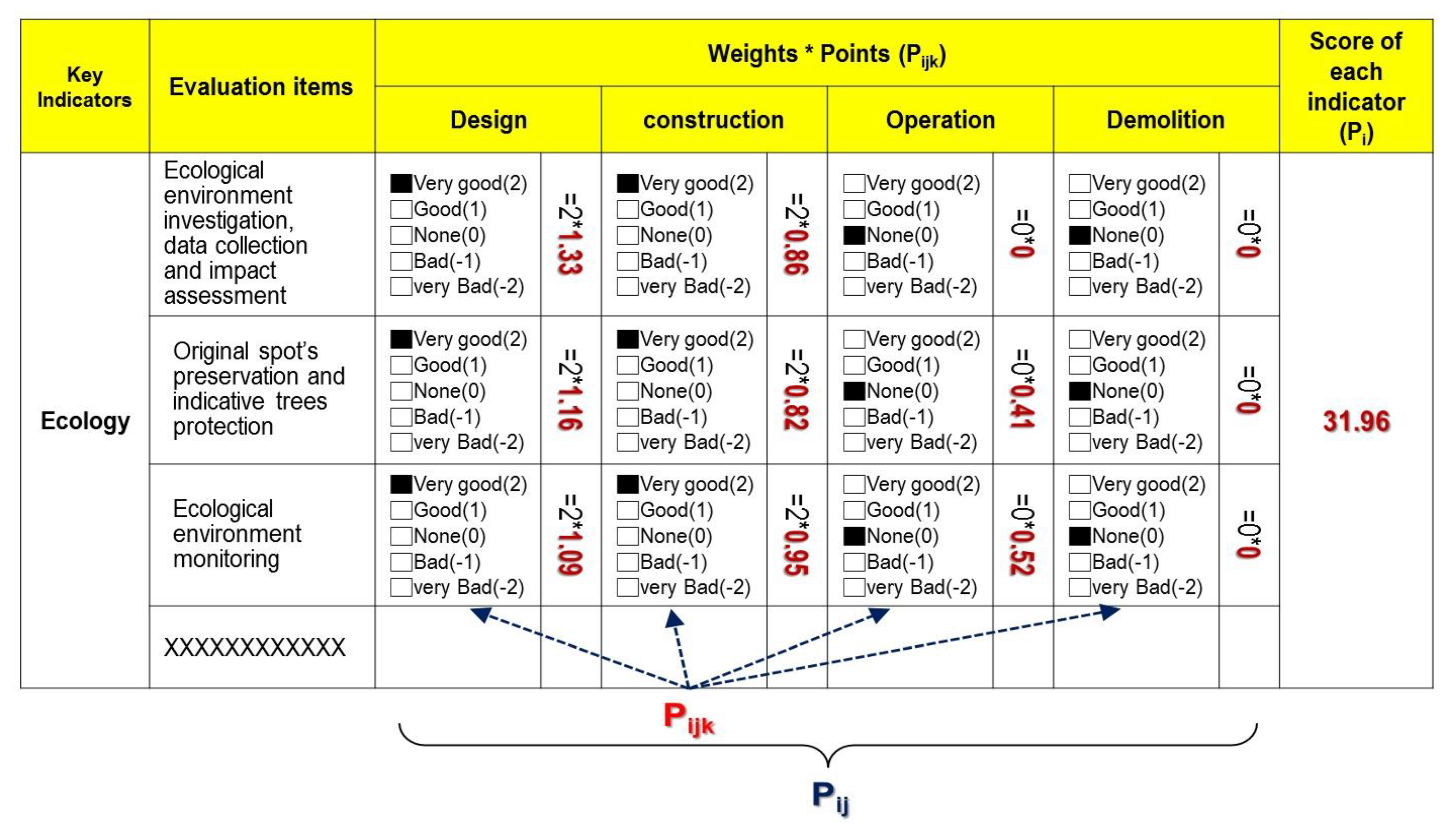

| Key Indicators | Evaluation Items |
|---|---|
| Risk Mitigation and Reliability |
|
| Ecology |
|
| Environmental Protection and Carbon Emissions Reduction(ER and CER) |
|
| Energy Saving |
|
| Waste Reduction |
|
| Durability |
|
| Benefit and function |
|
| Landscape |
|
| Humanities and Culture Preservation (H and C) |
|
| Creativity |
|
| Equation | Design | Construction | Operation | Demolition |
|---|---|---|---|---|
| Rk = (1/n) × ∑ Rak | 38.68% | 30.95% | 19.56% | 10.80% |
| Evaluation Items | Stages | n4 | n3 | n2 | n1 | n0 | Mean |
|---|---|---|---|---|---|---|---|
| Ecological environment investigation, data collection, and impact assessment | Design | 28 | 13 | 4 | 2 | 0 | 3.4 |
| Construction | 15 | 15 | 8 | 9 | 0 | 2.8 | |
| Operation | |||||||
| Demolition | |||||||
| Site preservation and indicative trees protection | Design | 17 | 19 | 5 | 6 | 0 | 3.0 |
| Construction | 10 | 20 | 11 | 3 | 3 | 2.7 | |
| Operation | 6 | 12 | 15 | 9 | 5 | 2.1 | |
| Demolition | |||||||
| Ecological environment monitoring | Design | 15 | 16 | 10 | 4 | 2 | 2.8 |
| Construction | 18 | 19 | 5 | 5 | 0 | 3.1 | |
| Operation | 14 | 15 | 9 | 6 | 3 | 2.7 | |
| Demolition | |||||||
| Selection of low impact construction methods and preservation of biodiversity and animal habitat integrity. Establishment of safety facilities for animals | Design | 27 | 11 | 7 | 2 | 0 | 3.3 |
| Construction | 26 | 16 | 3 | 6 | 0 | 3.4 | |
| Operation | 13 | 11 | 15 | 6 | 2 | 2.6 | |
| Demolition |
| Evaluation Items | Stages | Mean | Top Two Ratio | W2jk |
|---|---|---|---|---|
| Ecological environment investigation, data collection, and impact assessment | Design | 3.4 | 87.23% | 1.16 |
| Construction | 2.8 | 63.83% | 0.55 | |
| Operation | ||||
| Demolition | ||||
| Site preservation and indicative trees protection | Design | 3.0 | 76.60% | 0.89 |
| Construction | 2.7 | 63.83% | 0.53 | |
| Operation | 2.1 | 38.30% | 0.16 | |
| Demolition | ||||
| Ecological environment monitoring | Design | 2.8 | 65.96% | 0.72 |
| Construction | 3.1 | 78.72% | 0.75 | |
| Operation | 2.7 | 61.70% | 0.32 | |
| Demolition | ||||
| Selection of low impact construction methods and preservation of biodiversity and animal habitat integrity. Establishment of safety facilities for animals | Design | 3.3 | 80.85% | 1.04 |
| Construction | 3.4 | 89.36% | 0.94 | |
| Operation | 2.6 | 51.06% | 0.26 | |
| Demolition |
| Evaluation Items | Stages | W2jk | W2j | S2 |
|---|---|---|---|---|
| Ecological environment investigation, data collection, and impact assessment | Design | 1.16 | 0.85 | 0.679 |
| Construction | 0.55 | |||
| Operation | ||||
| Demolition | ||||
| Site preservation and indicative trees protection | Design | 0.89 | 0.52 | |
| Construction | 0.53 | |||
| Operation | 0.16 | |||
| Demolition | ||||
| Ecological environment monitoring | Design | 0.72 | 0.59 | |
| Construction | 0.75 | |||
| Operation | 0.32 | |||
| Demolition | ||||
| Selection of low impact construction methods and preservation of biodiversity and animal habitat integrity. Establishment of safety facilities for animals | Design | 1.04 | 0.75 | |
| Construction | 0.94 | |||
| Operation | 0.26 | |||
| Demolition |
| Sustainability Key Indicators | Evaluation Items | Wij | Si |
|---|---|---|---|
| Risk Mitigation and Reliability | Providing large enough safety factor in the design | 1.36 | 0.985 |
| Considering a second disaster prevention mechanism for the life cycle of the facility | 0.75 | ||
| External review/approval mechanism for design results | 0.79 | ||
| Avoiding geologically sensitive areas | 1.27 | ||
| Design and construction documents approved by certified professional engineers | 1.14 | ||
| Establishment of risk mitigation mechanism | 0.81 | ||
| Minimization of the interference to the flooding and disaster protection | 0.83 | ||
| Establishment of feasible operations management system to ensure user safety | 0.92 | ||
| Periodical disaster prevention drill in the life cycle | |||
| Ecology | Ecological environment investigation, data collection, and impact assessment | 0.85 | 0.679 |
| Site preservation and indicative trees protection | 0.52 | ||
| Ecological environment monitoring | 0.59 | ||
| Selection of low impact construction methods and preservation of biodiversity and animal habitat integrity. Establishment of safety facilities for animals | 0.75 | ||
| Environmental Protection and Carbon Emissions Reduction | Environmental impact assessment | 0.58 | 0.608 |
| Monitoring of carbon emission in the life cycle | 0.48 | ||
| Selection of low carbon emission materials | 0.73 | ||
| Construction methods and procedures with low air pollution Reduce the carbon emission in the life cycle and select the construction methods with low-carbon emissions | 0.61 | ||
| Adoption of permeable pavement to preserve water | 0.64 | ||
| Energy Saving | Adoption of green energy (e.g., solar energy, wind energy) | 0.23 | 0.458 |
| Selection of energy-saving materials and construction methods | 0.50 | ||
| Use of local materials to save energy and to reduce carbon emission | 0.60 | ||
| Use of energy-saving machinery to reduce energy consumption | 0.45 | ||
| Design and selection of energy-saving electrical and mechanical equipment | 0.47 | ||
| Periodic maintenance for equipment in the life cycle | 0.50 | ||
| Waste Reduction | Use of recyclable and environmentally friendly materials | 0.53 | 0.546 |
| Adoption of waste reduction construction methods (e.g., precast, modularization) | 0.74 | ||
| Use of industrial or construction by-product (e.g., fly ash, ground-granulated blast-furnace slag, reservoir silt) | 0.80 | ||
| Water resource recycling | 0.07 | ||
| Adoption of the public soil exchange mechanism | 0.54 | ||
| Balance of cut and fill at the same site | 0.59 | ||
| Durability | Durable structure design. | 1.01 | 0.968 |
| Use of durable materials. | 0.95 | ||
| Establishment of quality assurance measures to increase the life expectancy of the structures | 0.88 | ||
| Adoption of design that facilitates easy maintenance. | 1.03 | ||
| Benefit and Function | The satisfaction of the design function | 0.81 | 0.623 |
| Boost of the local economy and increase of the job market | 0.36 | ||
| Enhancement of the design/construction/operation quality and ability | 0.68 | ||
| Shortening of construction duration to maximize the benefit | 0.77 | ||
| Cost down in the life cycle | 0.48 | ||
| Landscape | Consideration of local culture in the structure design | 0.65 | 0.740 |
| Beautification of structure and landscape. Design of structure for landscape fusion | 0.83 | ||
| Humanities and Culture Preservation | Provision of participation and communication to the public | 0.31 | 0.358 |
| Safeguarding of social justice and care for minorities | 0.20 | ||
| Protection of historical sites and cultural relics | 0.57 | ||
| Creativity | Introduction of new materials, new construction methods, new technologies, and so on | 0.46 | 0.452 |
| Innovation in engineering project design | 0.44 | ||
| Establishment of incentives mechanism to encourage innovation | 0.52 | ||
| Application of value engineering | 0.39 |
| Key Indicators | Evaluation Items | Wijk | Wij | Wi | |||
|---|---|---|---|---|---|---|---|
| Risk Mitigation and Reliability | Item 1 | 1.36 | 1.36 | 15.3% | |||
| Item 2 | 1.25 | 0.55 | 0.47 | 0.75 | |||
| Item 3 | 0.79 | 0.79 | |||||
| Item 4 | 1.27 | 1.27 | |||||
| Item 5 | 1.33 | 0.96 | 1.14 | ||||
| Item 6 | 1.11 | 1.08 | 0.23 | 0.81 | |||
| Item 7 | 1.29 | 0.99 | 0.19 | 0.83 | |||
| Item 8 | 1.20 | 0.65 | 0.92 | ||||
| Item 9 | |||||||
| Ecology | Item 1 | 1.16 | 0.55 | 0.85 | 10.6% | ||
| Item 2 | 0.89 | 0.53 | 0.16 | 0.52 | |||
| Item 3 | 0.72 | 0.75 | 0.32 | 0.59 | |||
| Item 4 | 1.04 | 0.94 | 0.26 | 0.75 | |||
| Environmental Protection and Carbon Emissions Reduction (EP and CER) | Item 1 | 1.28 | 0.61 | 0.28 | 0.17 | 0.58 | 9.5% |
| Item 2 | 0.72 | 0.72 | 0.36 | 0.12 | 0.48 | ||
| Item 3 | 1.21 | 0.65 | 0.33 | 0.73 | |||
| Item 4 | 1.10 | 0.96 | 0.19 | 0.18 | 0.61 | ||
| Item 5 | 0.95 | 0.69 | 0.28 | 0.64 | |||
| Energy Saving | Item 1 | 0.26 | 0.17 | 0.27 | 0.23 | 7.1% | |
| Item 2 | 0.97 | 0.30 | 0.22 | 0.50 | |||
| Item 3 | 0.60 | 0.00 | 0.60 | ||||
| Item 4 | 0.68 | 0.21 | 0.45 | ||||
| Item 5 | 0.68 | 0.32 | 0.40 | 0.47 | |||
| Item 6 | 0.69 | 0.32 | 0.49 | 0.50 | |||
| Waste Reduction | Item 1 | 0.87 | 0.43 | 0.29 | 0.53 | 8.5% | |
| Item 2 | 1.21 | 0.91 | 0.12 | 0.74 | |||
| Item 3 | 0.93 | 0.66 | 0.80 | ||||
| Item 4 | 0.07 | 0.07 | |||||
| Item 5 | 0.80 | 0.67 | 0.15 | 0.54 | |||
| Item 6 | 0.98 | 0.71 | 0.10 | 0.59 | |||
| Durability | Item 1 | 1.51 | 0.51 | 1.01 | 15.1% | ||
| Item 2 | 1.43 | 0.84 | 0.57 | 0.95 | |||
| Item 3 | 1.06 | 0.98 | 0.60 | 0.88 | |||
| Item 4 | 1.41 | 0.66 | 1.03 | ||||
| Benefit and Function | Item 1 | 1.11 | 0.52 | 0.81 | 9.7% | ||
| Item 2 | 0.57 | 0.45 | 0.06 | 0.36 | |||
| Item 3 | 1.02 | 0.65 | 0.37 | 0.68 | |||
| Item 4 | 0.85 | 0.70 | 0.77 | ||||
| Item 5 | 0.94 | 0.41 | 0.10 | 0.48 | |||
| Landscape | Item 1 | 1.23 | 0.44 | 0.30 | 0.65 | 11.5% | |
| Item 2 | 1.43 | 0.71 | 0.33 | 0.83 | |||
| Humanities and Culture (H and C) | Item 3 | 0.61 | 0.31 | 0.23 | 0.08 | 0.31 | 5.6% |
| Item 4 | 0.33 | 0.19 | 0.07 | 0.20 | |||
| Item 5 | 0.83 | 0.58 | 0.30 | 0.57 | |||
| Creativity | Item 1 | 0.82 | 0.50 | 0.06 | 0.46 | 7.0% | |
| Item 2 | 0.80 | 0.43 | 0.08 | 0.44 | |||
| Item 3 | 0.84 | 0.62 | 0.12 | 0.52 | |||
| Item 4 | 0.64 | 0.13 | 0.39 | ||||
| Design | Construction | Operation | Demolition | |
|---|---|---|---|---|
| Risk Mitigation and Reliability | ||||
| Providing large enough safety factor in the design | 2 | N/A | N/A | N/A |
| Considering a second disaster prevention mechanism for the life cycle of the facility | 0 | 0 | 0 | N/A |
| External review/approval mechanism for design results | 0 | N/A | N/A | N/A |
| Avoiding geologically sensitive areas | 0 | 0 | 0 | N/A |
| Design and construction documents approved by certified professional engineers | 2 | 2 | N/A | N/A |
| Establishment of risk mitigation mechanism | 2 | 2 | N/A | 0 |
| Minimization of the interference to the flooding and disaster protection | 2 | 2 | 2 | N/A |
| Establishment of feasible operations management system to ensure user safety | 2 | N/A | 2 | N/A |
| Periodical disaster prevention drill in the life cycle | 0 | 0 | 2 | N/A |
| Ecology | ||||
| Ecological environment investigation, data collection, and impact assessment | 2 | 2 | N/A | N/A |
| Site preservation and indicative trees protection | 2 | 2 | 0 | N/A |
| Ecological environment monitoring | 2 | 2 | 0 | N/A |
| Selection of low impact construction methods and preservation of biodiversity and animal habitat integrity. Establishment of safety facilities for animals | 2 | 2 | 2 | N/A |
| Environmental Protection and Carbon Emissions Reduction (ER and CER) | ||||
| Environmental impact assessment | 2 | 2 | 0 | 0 |
| Monitoring of carbon emission in the life cycle | 2 | 2 | 1 | 0 |
| Selection of low carbon emission materials | 2 | 0 | 1 | N/A |
| Construction methods and procedures with low air pollution. Reduce the carbon emission in the life cycle and select the construction methods with low-carbon emissions | 2 | 2 | 0 | 0 |
| Adoption of permeable pavement to preserve water | 1 | 1 | 1 | N/A |
| Energy Saving | ||||
| Adoption of green energy (e.g., solar energy, wind energy) | 0 | 0 | 0 | N/A |
| Selection of energy-saving materials and construction methods | 2 | 2 | 0 | N/A |
| Use of local materials to save energy and to reduce carbon emission | 2 | 2 | 0 | N/A |
| Use of energy-saving machinery to reduce energy consumption | N/A | 2 | N/A | 0 |
| Design and selection of energy-saving electrical and mechanical equipment | 1 | 1 | 2 | N/A |
| Periodic maintenance for equipment in the life cycle | 1 | 2 | 2 | 0 |
| Waste Reduction | ||||
| Use of recyclable and environmentally friendly materials | 2 | 2 | 2 | N/A |
| Adoption of waste reduction construction methods (e.g., precast, modularization) | 0 | 1 | N/A | 0 |
| Use of industrial or construction by-product (e.g., fly ash, ground-granulated blast-furnace slag, reservoir silt) | 2 | 2 | N/A | N/A |
| Water resource recycling | 0 | 1 | 0 | 0 |
| Adoption of the public soil exchange mechanism | 2 | 2 | N/A | 0 |
| Balance of cut and fill at the same site | 2 | 2 | N/A | 0 |
| Durability | ||||
| Durable structure design | 2 | N/A | 2 | N/A |
| Use of durable materials | 2 | 1 | 2 | N/A |
| Establishment of quality assurance measures to increase the life expectancy of the structures | 2 | 2 | 2 | N/A |
| Adoption of design that facilitates easy maintenance | 2 | N/A | 2 | N/A |
| Benefit and Function | ||||
| The satisfaction of the design function | 2 | N/A | 2 | N/A |
| Boost of the local economy and increase of the job market | 2 | 2 | 0 | 0 |
| Enhancement of the design/construction/operation quality and ability | 2 | 2 | 1 | N/A |
| Shortening of construction duration to maximize the benefit | 2 | 2 | N/A | N/A |
| Cost down in the life cycle | 2 | 2 | 1 | 0 |
| Landscape | ||||
| Consideration of local culture in the structure design | 2 | 2 | 2 | N/A |
| Beautification of structure and landscape. Design of structure for landscape fusion | 2 | 2 | 2 | N/A |
| Humanities and Culture Preservation (H and C) | ||||
| Provision of participation and communication to the public | 0 | 2 | 1 | 0 |
| Safeguarding of social justice and care for minorities | 1 | 1 | 2 | 0 |
| Protection of historical sites and cultural relics | 2 | 2 | 0 | N/A |
| Creativity | ||||
| Introduction of new materials, new construction methods, new technologies, and so on | 2 | 2 | 0 | 0 |
| Innovation in engineering project design | 2 | 1 | N/A | 0 |
| Establishment of incentives mechanism to encourage innovation | 1 | 1 | 0 | 0 |
| Application of value engineering | 0 | 0 | N/A | N/A |
| Ecology | Design | Construction | Operation | Demolition |
|---|---|---|---|---|
| Ecological environment investigation, data collection, and impact assessment | 1.16 | 0.55 | ||
| Site preservation and indicative trees protection | 0.89 | 0.53 | 0.16 | |
| Ecological environment monitoring | 0.72 | 0.75 | 0.32 | |
| Selection of low impact construction methods and preservation of biodiversity and animal habitat integrity. Establishment of safety facilities for animals | 1.04 | 0.94 | 0.26 |
| Key Indicators | Evaluation Items | Pijk × Wijk | Pi | AF | FS | |||
|---|---|---|---|---|---|---|---|---|
| Risk mitigation and reliability | Item 1 | 2.73 | 3.12 | 6.192 | 84.50 | |||
| Item 2 | 0.00 | 0.00 | 0.00 | |||||
| Item 3 | 0.00 | |||||||
| Item 4 | 0.00 | 0.00 | 0.00 | |||||
| Item 5 | 2.65 | 1.92 | ||||||
| Item 6 | 2.23 | 2.17 | ||||||
| Item 7 | 2.59 | 1.99 | 0.39 | |||||
| Item 8 | 2.39 | 1.29 | ||||||
| Item 9 | 0.00 | 0.00 | ||||||
| Ecology | Item 1 | 2.31 | 1.09 | 1.44 | ||||
| Item 2 | 1.78 | 1.05 | 0.00 | |||||
| Item 3 | 1.43 | 1.49 | 0.00 | |||||
| Item 4 | 2.09 | 1.88 | 0.51 | |||||
| Environmental Protection and Carbon Emissions Reduction | Item 1 | 2.56 | 1.23 | 0.00 | 0.00 | 1.43 | ||
| Item 2 | 1.44 | 1.43 | 0.36 | 0.00 | ||||
| Item 3 | 2.41 | 0.00 | 0.33 | |||||
| Item 4 | 2.20 | 1.92 | 0.00 | 0.00 | ||||
| Item 5 | 0.95 | 0.00 | 0.28 | |||||
| Energy Saving | Item 1 | 0.00 | 0.00 | 0.00 | 0.64 | |||
| Item 2 | 1.94 | 0.61 | 0.00 | |||||
| Item 3 | 0.00 | 1.20 | 0.00 | |||||
| Item 4 | 1.37 | 0.00 | ||||||
| Item 5 | 0.68 | 0.00 | 0.80 | |||||
| Item 6 | 0.69 | 0.63 | 0.99 | 0.00 | ||||
| Waste Reduction | Item 1 | 1.74 | 0.85 | 0.58 | 1.15 | |||
| Item 2 | 0.00 | 0.91 | 0.00 | |||||
| Item 3 | 1.86 | 1.32 | ||||||
| Item 4 | 0.00 | 0.00 | 0.00 | 0.00 | ||||
| Item 5 | 1.59 | 1.34 | 0.00 | |||||
| Item 6 | 1.96 | 1.41 | 0.00 | |||||
| Durability | Item 1 | 3.03 | 1.02 | 2.76 | ||||
| Item 2 | 2.87 | 0.84 | 1.14 | |||||
| Item 3 | 2.13 | 1.95 | 1.20 | |||||
| Item 4 | 2.82 | 1.32 | ||||||
| Benefit and Function | Item 1 | 2.21 | 1.04 | 1.40 | ||||
| Item 2 | 1.14 | 0.90 | 0.00 | 0.00 | ||||
| Item 3 | 2.03 | 1.31 | 0.37 | |||||
| Item 4 | 1.70 | 1.39 | ||||||
| Item 5 | 1.88 | 0.00 | 0.41 | 0.00 | ||||
| Landscape | Item 1 | 2.46 | 0.87 | 0.60 | 1.02 | |||
| Item 2 | 2.87 | 1.42 | 0.67 | |||||
| Humanities and Culture | Item 1 | 0.00 | 0.62 | 0.23 | 0.00 | 0.24 | ||
| Item 2 | 0.33 | 0.00 | 0.37 | 0.00 | ||||
| Item 3 | 1.66 | 1.16 | 0.00 | |||||
| Creativity | Item 1 | 1.65 | 0.99 | 0.00 | 0.00 | 0.43 | ||
| Item 2 | 1.60 | 0.43 | 0.00 | |||||
| Item 3 | 0.84 | 0.62 | 0.00 | 0.00 | ||||
| Item 4 | 0.00 | 0.00 | 0.00 | 0.00 | ||||
Publisher’s Note: MDPI stays neutral with regard to jurisdictional claims in published maps and institutional affiliations. |
© 2021 by the authors. Licensee MDPI, Basel, Switzerland. This article is an open access article distributed under the terms and conditions of the Creative Commons Attribution (CC BY) license (https://creativecommons.org/licenses/by/4.0/).
Share and Cite
Liu, T.-Y.; Liu, G.-T.; Chen, P.-H.; Chou, N.N.S.; Ho, S.-P. Establishment of a Sustainability Assessment System for Bridges. Sustainability 2021, 13, 4795. https://doi.org/10.3390/su13094795
Liu T-Y, Liu G-T, Chen P-H, Chou NNS, Ho S-P. Establishment of a Sustainability Assessment System for Bridges. Sustainability. 2021; 13(9):4795. https://doi.org/10.3390/su13094795
Chicago/Turabian StyleLiu, Tai-Yi, Guan-Ting Liu, Po-Han Chen, Nelson N. S. Chou, and Shih-Ping Ho. 2021. "Establishment of a Sustainability Assessment System for Bridges" Sustainability 13, no. 9: 4795. https://doi.org/10.3390/su13094795







